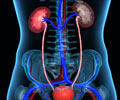A fist-sized tumour from the brain of an Indiana woman has been successfully removed by experts at the University of Cincinnati by using a technology that involves the fusion of four different types of images into a 3-D map of a patient's brain.
An eight-member team from the Brain Tumor Center at the UC Neuroscience Institute carried out the operation at University Hospital."This marks the culmination of one of the most important developments in brain tumor surgery in the last 100 years," says Dr. John Tew, a neurosurgeon with the Mayfield Clinic, professor of neurosurgery and clinical director of the UC Neuroscience Institute.
For the surgery, Tew and his team fused and installed the multiple brain scans into a surgical guidance computer, whose function is similar to a global positioning system.
They say that the technology revealed the tumour's relationship to all of the functional centres, electrical pathways and arteries and veins in the patient's brain, which is why they were able to map out a safe pathway to the tumour.
"This fusion of images is exciting in that it allows us to maximize resection (removal) of the tumour while preserving function for the patient," says Dr. James Leach, an associate professor of neuroradiology at UC who performed the processing and fusion of images.
Since early 2007, specialists have used the fusion of three types of imaging as a guide to stereotactic surgery-Magnetic resonance imaging (MRI) that creates detailed pictures of the body by detecting differences in magnetic signals between different types of tissues; functional magnetic resonance imaging (fMRI) that creates a series of images that capture blood oxygen levels in parts of the brain that are responsible for movement, perception and cognition; and diffusion tensor imaging (DTI) that provides a map of critical white-matter tracts, which facilitate electrical connections between different parts of the brain.
Advertisement
"The 3T system allows us to image the functional areas of the brain using various language, motor and vision tasks with the patient in the MRI scanner. The addition of the DTI sequence allows the connections between these areas and other parts of the nervous system to be identified at the same time," Leach says.
Advertisement
According to the researcher, the patient was talking normally right after surgery, and she was walking the halls and able to take a shower without assistance one day after surgery. he team sought to eradicate the remaining tumour by applying a course of 33 computer-guided, fractionated radiotherapy treatments as a first approach.
Source-ANI
RAS















